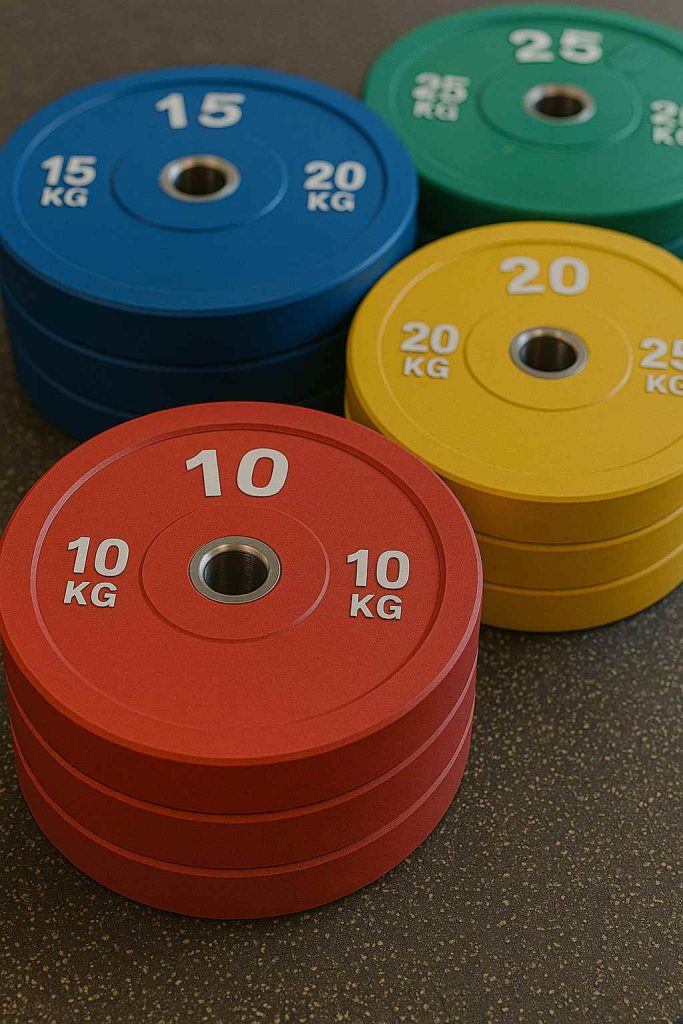Bumper plates are specialized weightlifting plates made with thick rubber or urethane to protect gym floors and equipment, especially when dropped from overhead. If you’re serious about Olympic lifting, CrossFit, or want to keep your home gym quiet and damage-free, understanding bumper plates is essential. They’re a must-have for anyone looking to perform lifts safely and efficiently. In this guide, you’ll learn what bumper plates are, how they differ from traditional iron plates, the types available, current pricing, and how to choose the best option for your needs.

For full specifications and current policies, you can also check out the International Weightlifting Federation’s technical rules.
What Are Bumper Plates?
Bumper plates are weight plates coated with dense rubber or urethane, designed for Olympic barbells. The key feature that separates them from standard iron plates is their ability to be dropped safely from overhead. All bumper plates—regardless of weight—are made to the same standard diameter (450 mm/17.72 inches per IWF specs), so the bar always starts at the correct height for lifts.
Quick Facts
- Materials: Rubber, urethane, or crumb rubber
- Diameter: Always 450 mm (about 17.7 inches)
- Center Hole: 2 inches (fits Olympic bars)
- Purpose: Minimize damage to floors, bars, and plates when dropped
Why does this matter? Consistent diameter protects both lifter and equipment, and the rubber coating prevents damage and reduces noise (Montreal Weights, 2024).
Benefits of Using Bumper Plates
Protects Your Floors and Equipment
Dropping iron plates can crack tiles or concrete and warp bars. Bumper plates absorb the impact—keeping your floors and equipment safe.
Reduces Noise
Rubber construction keeps things quieter—great for home gyms, apartments, or commercial spaces where noise is a concern (SuperStrong, 2024).
Safer for High-Rep or Olympic Lifting
Olympic lifts like snatches and clean & jerks often end with the bar being dropped. Bumper plates are made for these movements, making them a staple for CrossFit and Olympic weightlifting.
Easier on Beginners
Lightweight technique plates (5-10 lb or kg) allow new lifters to practice with proper bar height and safe drops.
Types of Bumper Plates
1. Standard Rubber Bumper Plates
- Most common for gyms and CrossFit boxes.
- Offer a good mix of durability, affordability, and moderate bounce.
- Prices (2024): Around $2.50–$4 per pound (Gluck’s Gym, 2024).
2. Urethane Bumper Plates
- More durable, less bounce, and virtually odorless.
- Best for commercial gyms, but more expensive.
- Prices: $3–$6 per pound.
3. Competition Bumper Plates
- IWF-certified, precise weight tolerance (within 10–15 grams).
- Slim profile for loading heavy weights.
- Distinct color coding for easy identification.
- Typically $4–$7 per pound.
4. Crumb Rubber/Hi-Temp Bumper Plates
- Made from recycled rubber, bulkier and bouncier.
- Extra durable but take up more space on the bar.
- Eco-friendly option, often found in high school or college gyms.
5. Technique Plates
- Ultra-light (2.5–5 kg), full-diameter for teaching safe lifting.
- Excellent for beginners or injury rehab.
Bumper Plates vs. Cast Iron Plates
| Feature | Bumper Plates | Cast Iron Plates |
|---|---|---|
| Drop Safe? | Yes | No |
| Floor Protection | Excellent | Poor |
| Noise | Quiet | Loud |
| Thickness | Thicker | Thinner |
| Price | $$–$$$ | $ |
| Main Use | Olympic/CrossFit, Home Gym | Powerlifting, Bodybuilding |
Bumper plates cost more but protect your space and equipment. Cast iron plates are affordable but risky to drop and much noisier (PowerliftingTechnique, 2024).
Who Should Use Bumper Plates?
- Olympic lifters & CrossFitters: Essential for movements involving overhead drops.
- Home gym owners: Ideal for noise control and floor protection.
- Personal trainers: Provide a safer, more versatile training environment for clients.
- Beginners: Technique bumpers help with learning lifts safely.
- Anyone renting or in an apartment: Reduce complaints about noise and floor damage.
How to Choose the Best Bumper Plates
- Budget: Standard rubber plates are most cost-effective; urethane and competition are premium.
- Space: If you need to load heavy weights on a short bar, go for competition plates (thinner).
- Environment: Crumb rubber is best for rough surfaces or outdoor training.
- Training Style: Olympic/CrossFit? Standard or competition. Powerlifting? Maybe iron.
Check for warranty, weight accuracy, and brand reputation before you buy.
Pricing & Where to Buy
- Standard bumper plates: $2.50–$4.00 per lb
- Urethane bumper plates: $3.00–$6.00 per lb
- Competition bumper plates: $4.00–$7.00 per lb
Shop at major suppliers like Rogue Fitness, Titan Fitness, and REP Fitness for up-to-date inventory and deals.
Frequently Asked Questions
Are bumper plates necessary for home gyms?
Yes, if you plan to do Olympic lifts or want to protect your floors. Even for general lifting, they offer peace of mind and reduce noise.
Do bumper plates fit all barbells?
They fit Olympic (2-inch sleeve) bars. Not for standard 1-inch bars.
Can you mix bumper plates and iron plates?
You can, but always load bumpers first (closest to collars) to protect both bar and plates.
How long do bumper plates last?
Good-quality bumpers can last 5–10 years or longer with normal use. Urethane plates last even longer.
Conclusion
Bumper plates are the safest, most versatile weight plates for Olympic lifts, CrossFit, and any situation where dropping weights is possible. They protect your equipment, floor, and ears—making them a smart investment for home and commercial gyms alike.
